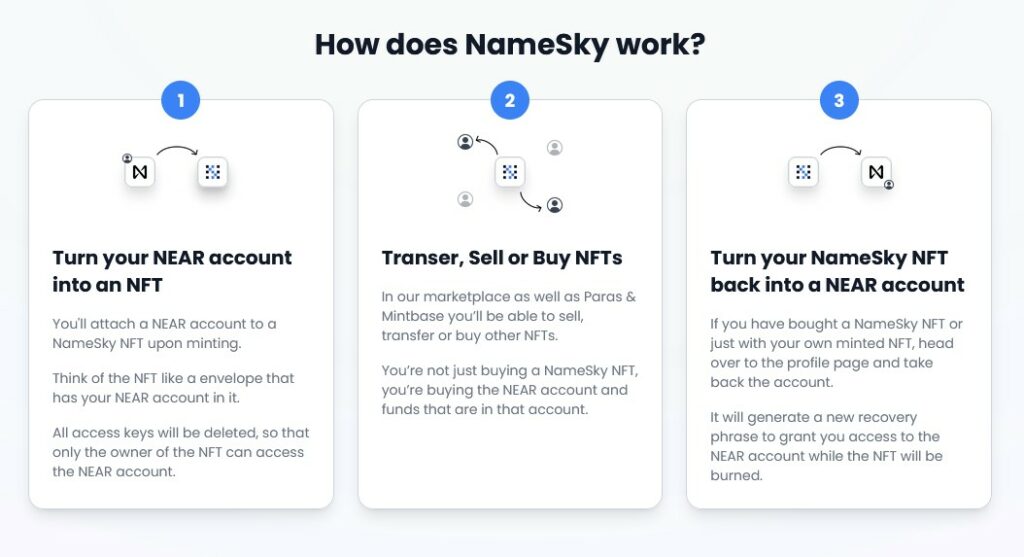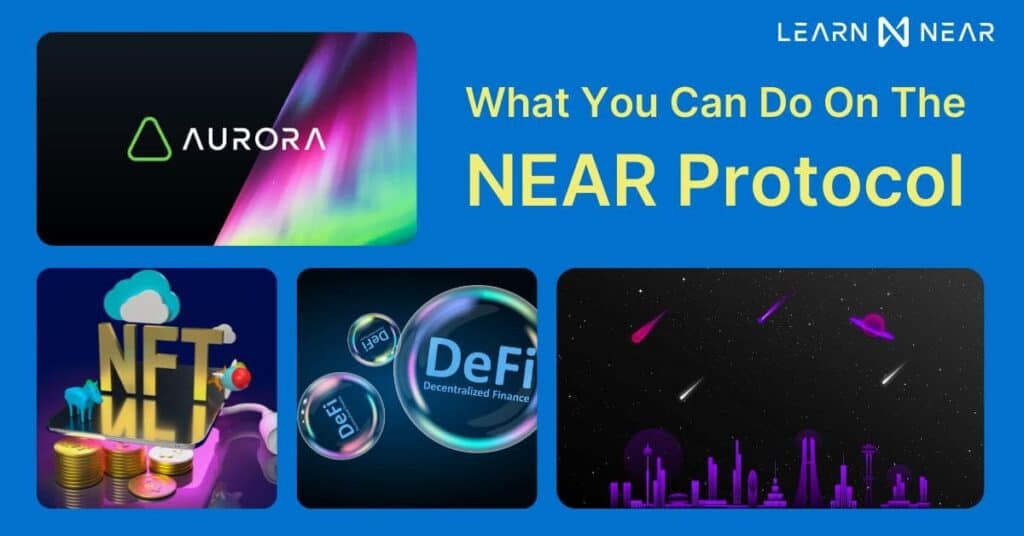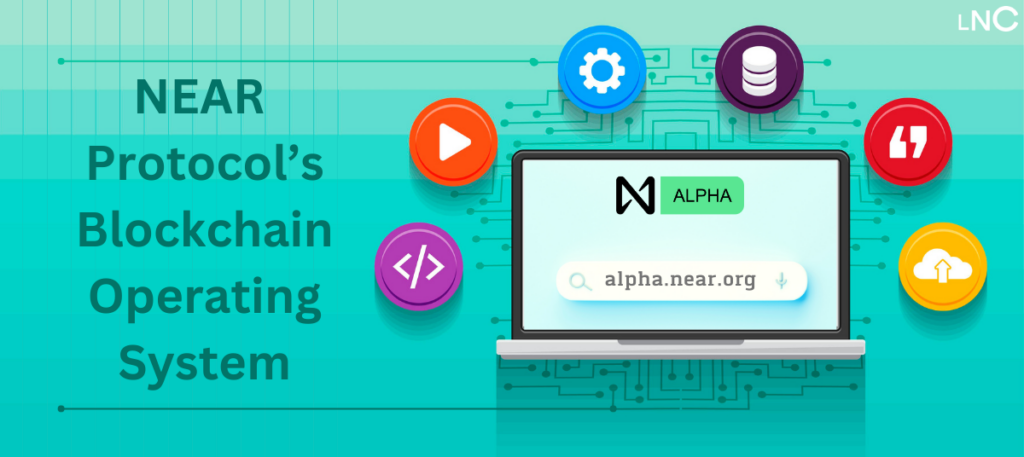In the crypto space, Ethereum dominates as the go-to platform when it comes to smart contracts, decentralized applications, and Decentralized Finance. However, Ethereum isn’t the only protocol in the smart contract and decentralized applications space, with several other protocols in the picture. Even though Ethereum is the number one platform in the space, it has quite a few shortcomings, such as extremely high gas fees and significant scalability issues.
NEAR Protocol is one of the blockchains that can rival Ethereum by going straight for the protocol’s most glaring shortcoming, its lack of scalability, by using something known as sharding. This allows NEAR to scale up its scalability exponentially. The protocol has also raised significant funding and counts Andreessen Horowitz’s a16z fund as one of its backers.
A Closer Look At The NEAR Protocol
The NEAR protocol is a decentralized development platform that was founded in 2018. NEAR creates the perfect environment for decentralized applications and smart contracts by focusing on the shortcomings of other protocols in the same space. We have already mentioned the shortcomings previously. NEAR utilizes the NEAR protocol, a Proof-of-Stake blockchain that is known for being public, developer-friendly, and sharded. The protocol is a low-cost and highly scalable platform that developers can utilize to create decentralized applications (dApps). Other features that developers can use include wallet applications and interoperability components that allow developers to easily utilize the NEAR ecosystem and build applications.
NEAR introduces Doomslug, a block generation mechanism that was proposed in 2019. It allows practical finality; meaning blocks can achieve finality in seconds. NEAR functions on the same technology powering technologies like Bitcoin and combines it with features such as database sharding. Other blockchains centralize processing which means that it is limited to very high-end hardware. This approach only provides a temporary boost to throughput. On the other hand, NEAR scales linearly and can support even billions of transactions in a completely decentralized manner.
Important Features Of NEAR
The NEAR protocol is developed by the NEAR Collective. Some of the protocol’s features are the following.
- NEAR as a protocol is simple to use, and developers can easily and quickly build apps on it
- NEAR allows for almost infinite scalability thanks to the use of sharding
- Near is a Layer-1 protocol.
Understanding The NEAR Collective
The NEAR Collective, a community of researchers and developers, is behind the development of the NEAR protocol. The collective is continuously working to develop and improve the NEAR protocol and has also worked on projects such as writing the initial code of the protocol and the implementation of the NEAR Network. The NEAR Protocol operates completely independently and decentralized, and even the developers and researchers who built it cannot shut it down.
The NEAR Collective consists of the NEAR Foundation, which is a non-profit organization creating an ecosystem around the NEAR protocol. The NEAR Collective helps in the development and governance activities on the protocol. The NEAR Protocol is just one of the several projects under the collective.
What Can You Do On The NEAR Protocol
The Near Protocol allows users to access several projects and protocols ranging from NFTs to DAOs and DeFi. NEAR has developed a vibrant native ecosystem has several projects that are already up and running on the protocol, while more projects are in the pipeline.
Getting Started With NEAR
To get started with NEAR, the first thing that you need is a NEAR account. You can learn how to set up a NEAR account here. Once you have created your NEAR account, you can connect it to your NEAR wallet, which allows you to make contract calls to the blockchain, send or receive funds and set up the local nodes. To create a NEAR account, you need to have at least 0.2 NEAR or 0.62 USD so that you can hold your place on the NEAR network.
The NEAR Token
There are two ways in which you can get NEAR tokens; you can either earn them or directly buy them. NEAR tokens can be earned by participating on the network, participating in developmental bounties, or running community nodes that can allow people in the community to build on NEAR. You can also buy NEAR tokens that are available on all major cryptocurrency exchanges.
What Can You Do With NEAR Tokens
The NEAR token allows you to do several tasks; you can transfer NEAR tokens between accounts and keep track of transactions on the Block Explorer. Transaction fees on NEAR are extremely low, allowing you to move tokens easily. You can also send NEAR to anyone who needs to create a NEAR account using NEAR Drops. NEAR tokens also allow you to access a growing number of applications that are being built on NEAR. They can also purchase, publish or trade NFTs and digital art on NEAR or create collective art creations.
Staking
The NEAR community can support validators through Staking. Validators are those users that operate nodes that help to run the NEAR network. Validators are required to maintain a minimum amount staked so that they can stay on as validators. Token holders on NEAR can stake with a validator of their choice and earn a reward from the tokens generated by the network. Users can stake using the following steps
- Select Staking from the navigation bar, and choose a validator
- Confirm the options you have selected, and then select “Stake with Validator”
- Choose the number of NEAR tokens that you want to stake and click on “Submit.”
What You Can Do On The NEAR Ecosystem
NFTs
NFTs have been gaining a significant amount of mainstream focus. While Ethereum is the primary player when it comes to NFTs, their move into the mainstream has also brought into focus Ethereum’s high gas fees, making it quite impractical. The NEAR Protocol is a viable alternative and already has several projects already running on its platform. The protocol’s scalability ensures that the development of dApps is made quick and easy. Currently, there are 19 decentralized platforms for NFT on NEAR platform. NEAR is also significantly faster than other players in the NFT space and has extremely low transaction costs.
The NEAR Protocol can be described as the perfect platform for NFTs and has several advantages over other NFT platforms in the space and even Ethereum. The NEAR protocol can process transactions much faster than Ethereum, and unlike Ethereum, it does not suffer from high gas fees or network congestion. Transactions on NEAR are processed almost instantly with a negligible cost attached. All these factors make NEAR ideal for buying and selling NFTs and act as an incentive for different projects to build their NFTs on NEAR. There are several NFT projects already running on NEAR, such as Mintbase and Paras.
Mint and Trade NEAR Accounts as NFTs at NameSky
NameSky is an NFT project on the NEAR blockchain. It’s built with utilities to make buy & sell NEAR accounts easy and secure as NFTs.

Every NFT represents the ownership of the attached NEAR account, i.e. buying an NFT with account id awesome.near means buying the awesome.near NEAR account.
Create And Sell NFTs through Mintbase
NEAR Protocol users can use several of the NFT projects to buy, sell or create NFTs. One such project, Mintbase, allows users to create an NFT and make it available for sale on marketplaces such as OpenSea. Users can create smart contracts to limit the transferability of the tokens, which helps prevent fraud and the illegal transfer of assets.
Mintbase switched from the Ethereum blockchain to NEAR protocol due to the former’s high gas fees. Initially, gas fees on Ethereum were low, and users could deploy quickly, however with increasing usage and congestion on Ethereum, gas costs started spiraling out of control. There are several other reasons why Mintbase chose NEAR Protocol.
- NEAR uses Rust or AssemblyScript to code smart contracts, allowing developers to write code easily.
- NEAR has human-readable addresses for smart contracts and accounts.
- Developers can use NEAR drops and onboard users easily and quickly. They can also pay for their NEAR accounts and send or receive NEAR tokens.
- Developers can use the ETH-NEAR Rainbow Bridge and move their assets quickly.
- DeFi projects such as Balancer and Aave are also on NEAR, making any potential future integration easy.
Create, Trade, And Collect Digital Art Cards
Paras is a digital card marketplace built on the NEAR protocol that provides users a solution for aging traditional collectible cards. It validates ownership through the blockchain through quick and inexpensive transactions. It also differentiates itself by offering collections instead of standalone releases. Paras is beneficial for collectors as it significantly reduces the burden on collectors by ensuring that their collectibles do not wear out. Artists and collectors both can easily access the collectibles market.
Since the launch of Paras, we have seen artists make more than $25,000, with the platform being able to process 700+ transactions that allowed it to facilitate a trading volume of over $35,000. Currently, the platform has over 70 artists and 80 collectors. The NEAR Protocol and Paras are a great fit because NFT creators are looking for alternatives to Ethereum with its high gas fees. Transactions on NEAR cost next to nothing and can be completed in seconds, while the Rainbow Bridge ensures interoperability between Ethereum and NEAR.
Explore And Auction NFT Collections
Protocol users can access several other NFT projects on NEAR, such as Metamon, WebAssembly Music, Snark.Art etc. Metamon creates a universe of monsters that users can capture, evolve and play with. The monsters are classified as endangered, limited edition creatures that a select group of NFT collectors can adopt. Collectors can combine two of the same type of Metamon and watch it evolve into a rarer, more powerful Metamon.
WebAssembly Music is the first music that has been stored on the blockchain as an NFT. The music is created by Peter Salomonsen and is published on the NEAR Protocol. The piece of music was among the first pieces of music that were rendered to an executable WebAssembly binary. Users can execute the WASM binary file and get the raw audio data through a WebAssembly runtime.
NEAR uses the following to code smart contracts:
DeFi On NEAR
Let’s first understand DeFi, DeFi, or Decentralized Finance refers to a completely decentralized financial system that utilizes blockchains like Ethereum. It consists of assets such as decentralized applications, DeFi protocols, and smart contracts. The goal behind DeFi is to create an open-source, permissionless, and decentralized financial system that operates independently from the jurisdiction of any third-party or central governing authority. DeFi gives users easy access to financial services and is especially beneficial to individuals who do not have access to banking services.
NEAR is bringing DeFi to the masses with several projects live on the protocol, with projects ranging from DeFi projects, DEXs, Oracles, etc. Let us look at how you can use some of the projects on NEAR.
Access Almost All Compatible Chains With Rainbow Bridge
The Rainbow Bridge acts as a bridge between NEAR and Ethereum and is a permissionless and trustless protocol that connects two different blockchains. Users can easily deploy a new bridge or join an existing bridge without needing approval from a third party. The Rainbow Bridge allows any information that can be used on NEAR to be utilized in Ethereum smart contracts and vice versa. This also enables users to vote with ETH on a DAO based on NEAR without going through Ethereum.
The Rainbow Bridge is easily accessible for users, thanks to an intuitive design, and onboard directly through MetaMask. The Rainbow Bridge can also be repurposed and connect NEAR with almost all Ethereum-compatible chains. The Rainbow Bridge is also looking to support non-EVM chains such as Bitcoin.
SputnikDAO
DAOs are extremely important when it comes to a protocol’s governance strategy. SputnikDAO empowers communities and individuals that make up the NEAR ecosystem, acting as the infrastructure for DAOs on the NEAR protocol and allow individuals and other projects to launch DAOs, upgrade protocol smart contracts, and configure governance for treasury management easily. SputnikDAO also enables projects to set up multi-signature governance or issue governance tokens or combine the two and use them together.
Release And Mint Audio NFTs With DAOrecords
DAOrecords plans to become the world’s first decentralized Record label and currently employs a hybrid model. The project has been continuously experimenting with Audio NFTs, with the project having released 350 NFTs and worked with over 60 artists so far. DAOrecords wants to control music back to the artists who created them and change the way they interact with their fans.
Independent artists can release new music using DAOrecord’s audio NFTs and streaming services. They can also mint their audio NFTs. DAOrecords has already published an interactive audio NFT called “MintTape Vol 1.”
Access Loans Through Aave
Aave implements a pool-based lending strategy instead of a decentralized peer-to-peer strategy. Loans on Aave are not matched individually. Instead, they rely on pooled funds and on the collateral along with the amounts borrowed. Aave was launched in November 2017 as a peer-to-peer lending platform and renamed Aave in September 2018. The protocol went live on the Mainnet, and has almost $6 Billion locked in smart contracts, and is in the top 3 projects in the DeFi space.
Aave offers flash loans, which are basically uncollateralized loans that are borrowed and repaid in a single transaction, which means that users do not require any collateral for the loan, while the borrower returns the original amount borrowed and a small fee. Aave introduced flash loans, where anyone can borrow liquidity, use it with other protocols, and repay it back in a single transaction. Flash loans are essential in the DeFi space as they give individuals access to liquidity without the need for collateral.
Access Data Feeds With Chainlink
Chainlink was developed as a decentralized oracle network that allows smart contracts to transfer data between blockchains and off-chain systems reliably and securely. It utilizes a decentralized network of independent oracles to retrieve data from multiple different resources, aggregate the data, and then deliver the validated data to the smart contract, which triggers the execution of the contract.
The Chainlink protocol also provides multi-layer security to ensure complete trust in the oracle network. It allows for the building and running of oracle networks, allowing users to connect to customized oracle networks without having to depend on other oracle networks.
- Data Signing – Chainlink oracles input data is signed using a unique cartographic signature that allows users to prove that the data originated from a specific oracle node.
- High-Quality Data – Chainlink will provide smart contracts with data sourced from external sources such as external data providers.
- Blockchain Agnostic – Chainlink is able to natively run on any blockchain, supporting public blockchains, enterprise blockchains, etc.
DAOrecords allows you to mint:
Aurora – An Ethereum Layer-2 Experience
Aurora on NEAR Protocol provides an Ethereum Layer-2 experience. Developers can use this to reach out to additional markets while taking advantage of the NEAR Protocol features such as gas fee remuneration and sharding. It runs on two critical components, the Aurora Bridge and the Aurora Engine. Here are some features that Aurora brings in:
- The ability to process thousands of transactions per second, a 50x increase over Ethereum.
- A block finality time of 2 seconds, as compared to the single block confirmation time of 13 seconds on Ethereum.
- Allows EVM to scale horizontally with NEAR’s sharding approach.
- Fees on Aurora are 1000x times lower than those on Ethereum.
- Aurora offers uncompromising compatibility with Ethereum over the NEAR Protocol.
Closing Thoughts
NEAR is creating an ecosystem where users can easily access dApps, NFTs, and DeFi. The protocol is faster and cheaper than other players in the crypto space. NEAR offers solutions for issues such as slow processing speeds, network congestion, and high gas fees by utilizing sharding, giving the platform a significant amount of scalability without compromising on the security of the protocol.
This protocol allows NEAR users to access Ethereum on layer-2:
Updated: May 17, 2023





Top comment
Near seems to be a big piece to this space but still undervalued. Can i mint an nft with near then move it to ether?
first time i know something about aurora. great post
first time i know something about aurora. great post
I buy alot of Auroratoken, hope
Отличные курсы мне очень нравится
Near poker was good
worst comment
worst comment